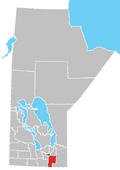Rural Municipality of Hanover | |
|---|---|
 Steinbach (upper) and Blumenort (lower) as seen from the air. | |
 The Location of the RM of Hanover in Manitoba | |
| Coordinates: 49°26′36″N96°50′57″W / 49.44333°N 96.84917°W | |
| Country | Canada |
| Province | Manitoba |
| Region | Eastman |
| Incorporated | May 25, 1881 |
| Amalgamated | 1890 |
| Government | |
| • Reeve | Jim Funk |
| Area | |
• Total | 730.44 km2 (282.02 sq mi) |
| Elevation | 268 m (879 ft) |
| Population | |
• Total | 17,216 |
| • Density | 23.6/km2 (61/sq mi) |
| Time zone | UTC-6 (CST) |
| • Summer (DST) | UTC-5 (CDT) |
| Website | http://www.hanovermb.ca/ |
The Rural Municipality of Hanover is a rural municipality (RM) in southeastern Manitoba, Canada, located southeast of Winnipeg in Division No. 2.
Contents
It is Manitoba's most populous rural municipality and fourth-most populous municipality overall (behind the cities of Winnipeg, Brandon, and Steinbach) as of the 2021 census.
